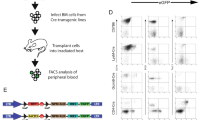Abstract
The production of recombinant retroviruses is an important episode in the natural history of thymic leukaemia in AKR and HRS/J (hr/hr) mice1,2. These viruses apparently originate from ecotropic and xenotropic precursors in the late preleukaemic stage of the disease. Analyses of their structural proteins3,4 and genomic oligonucleotides3,5 indicate that they arise by recombination of env genes of the precursor viruses. This event leads to a viral envelope glycoprotein (gp70) with some peptides that have features of the gp70 glycoproteins of ecotropic and xenotropic viruses, and others that are unique for each recombinant virus3,4,6. The former property explains the broad host range of recombinant viruses, and hence their designation as dual tropic1 or polytropic2 viruses. It has been postulated that the unique aspect of each recombinant's gp70 determines the phenotypes of leukaemic cells7. Polytropic viruses may be highly thymotropic. Their systemic administration results in an infection that confines itself virtually to the thymus3,8. Moreover, these viruses are leukaemogenic whereas their precursors are not, or only weakly so3,8,9. The leukaemogenicity of polytropic viruses is, however, restricted to certain inbred strains of mice3,8. The HRS/J isolate PTV-1 is leukaemogenic in HRS/J and CBA/J mice, but not in SWR/J or NIH/Swiss mice3. The experiments described here demonstrate that a single dominant gene permits infection of thymocytes by a leukaemogenic polytropic virus. CBA/J mice, which develop thymic leukaemia after infection by this virus, posesses this gene, whereas leukaemia-resistant NFS mice lack it.
This is a preview of subscription content, access via your institution
Access options
Subscribe to this journal
Receive 51 print issues and online access
$199.00 per year
only $3.90 per issue
Buy this article
- Purchase on Springer Link
- Instant access to full article PDF
Prices may be subject to local taxes which are calculated during checkout
Similar content being viewed by others
References
Hartley, J. W., Wolford, N. K., Old, L. J. & Rowe, W. P. Proc. natn. Acad. Sci. U.S.A. 74, 789–792 (1977).
Hiai, H., Morrissey, P., Khiroya, R. & Schwartz, R. S. Nature 279, 247–249 (1977).
Green, N. et al. J. exp. Med. 152, 249–264 (1980).
Elder, J. H. et al. Proc natn. Acad. Sci. U.S.A. 74, 4676–4680 (1977).
Rommelaere, J., Faller, D. V. & Hopkins, N. Proc. natn. Acad. Sci. U.S.A. 74, 495–499 (1978).
Elder, J. H., Jensen, F. C., Bryant, K. L. & Lerner, R. A. Nature 267, 23–28 (1977).
Zielinski, C. C., Waksal, S. D., Tempelis, L. D., Khiroya, R. H. & Schwartz, R. S. Nature 288, 489–490 (1980).
Cloyd, M. W., Hartley, J. W. & Rowe, W. P. J. exp. Med. 151, 542–552 (1980).
Nowinski, R. C. & Hayes, E. F. J. Virol. 27, 13–18 (1978).
Kawashima, K. et al. Proc. natn. Acad. Sci. U.S.A. 74, 789–792 (1976).
Stephenson, J. R. in Molecular Biology of RNA Tumor Viruses, 245–297 (Academic, New York, 1980).
Pincus, T. in Molecular Biology of RNA Tumor Viruses, 77–130 (Academic, New York, 1980).
Author information
Authors and Affiliations
Rights and permissions
About this article
Cite this article
Schwartz, R., Khiroya, R. A single dominant gene determines susceptibility to a leukaemogenic recombinant retrovirus. Nature 292, 245–246 (1981). https://doi.org/10.1038/292245a0
Received:
Accepted:
Published:
Issue Date:
DOI: https://doi.org/10.1038/292245a0
Comments
By submitting a comment you agree to abide by our Terms and Community Guidelines. If you find something abusive or that does not comply with our terms or guidelines please flag it as inappropriate.



